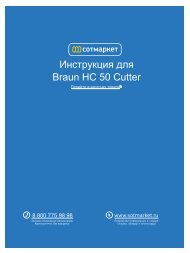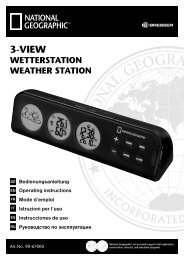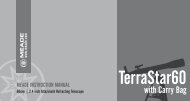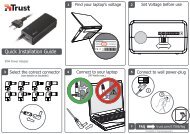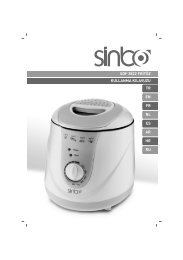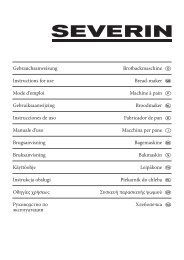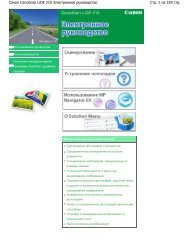gb 500w jigsaw user's manual 1 fr scie sauteuse 500w manuel d ...
gb 500w jigsaw user's manual 1 fr scie sauteuse 500w manuel d ...
gb 500w jigsaw user's manual 1 fr scie sauteuse 500w manuel d ...
You also want an ePaper? Increase the reach of your titles
YUMPU automatically turns print PDFs into web optimized ePapers that Google loves.
GB FR DE ES IT NL PT DK SE FI NO RU PL CZ HU RO LV LT EE HR SI SK GR TR<br />
Make sure the blade is inside the area to be cut.<br />
Start your saw by using high speed and slowly lower<br />
the blade into the workpiece until the blade cuts<br />
through the wood.<br />
Continue lowering the blade into the workpiece until<br />
the base rests flat on the work surface, then move the<br />
saw forward to complete the cut.<br />
Use only the 7 teeth per inch blade for this type of cut.<br />
METAL CUTTING<br />
Many kinds of metals can be cut with your saw.<br />
Be careful not to twist or bend the blades. Do not force.<br />
If the blade chatters or vibrates excessively, use a nertooth<br />
blade or higher speed. If blade heats excessively, use lower<br />
speed. If blade teeth become lled or clogged when cutting<br />
soft metals, such as aluminum, use a coarser-tooth blade<br />
or lower speed. We recommend the use of oil when cutting<br />
metals to keep blades cool, increase cutting action, and<br />
prolong blade life. Clamp the work rmly and cut close<br />
to the clamping point to eliminate any vibration of the<br />
workpiece being cut.<br />
When cutting conduit, pipe or angle iron, clamp work in a<br />
vise if possible and saw close to the vise. To cut thin sheet<br />
materials smoothly, "sandwich" the material between<br />
hardboard or plywood and clamp the layers to eliminate<br />
vibration and material tearing. By doing this, the material<br />
will be cut smoothly. Lay out your pattern or line of cut on<br />
top of the “sandwich".<br />
IMPORTANT!<br />
When cutting metal, keep exposed portion of saw bar<br />
clean and <strong>fr</strong>ee of metal chips by wiping <strong>fr</strong>equently with<br />
an oily cloth. Use extreme caution in disposing of oily<br />
cloth after completion of job to prevent potential re<br />
hazard.<br />
SAWDUST BLOWER DEVICE<br />
See Figure 7.<br />
With the air jet of the sawdust blower device, the<br />
cutting line can be kept <strong>fr</strong>ee of dust and chips.<br />
Switching on the sawdust blower device: For cuts in<br />
materials with high removal rate, such as in wood,<br />
plastic, etc.. Push dust blower button up.<br />
Switching off the sawdust blower device: For cuts<br />
in metal and when a dust extraction system (not<br />
included) is connected. Push dust blower button down.<br />
TO CONNECT DUST EXTRACTION SYSTEM (NOT IN-<br />
CLUDED)<br />
Unplug the tool.<br />
English<br />
3<br />
WARNING<br />
Failure to unplug your saw could result in accidental<br />
starting causing possible serious injury.<br />
Connect the nozzle of the dust collection system to<br />
the dust port.<br />
OPTIONAL EDGE GUIDE (NOT INCLUDED)<br />
See Figure 8.<br />
An edge guide is available for use with your saw and can<br />
be used for making crosscuts and rip cuts.<br />
TO INSTALL:<br />
Unplug your saw.<br />
WARNING<br />
Failure to unplug your saw could result in accidental<br />
starting causing possible serious injury.<br />
Insert arm of the edge guide through the two slots in<br />
the base of your saw.<br />
Adjust edge guide to the desired width and lock in<br />
place with the edge guide screw.<br />
WARNING<br />
When servicing, use only identical replacement parts.<br />
Use of any other parts may create a hazard or cause<br />
product damage.<br />
LIVE TOOL INDICATOR<br />
This tool features a live tool indicator which illuminates as<br />
soon as the tool is connected to the supply. This warns the<br />
user that the tool is connected and will operate when the<br />
switch is pressed.<br />
MAINTENANCE<br />
GENERAL<br />
All other parts represent an important part of the class<br />
II insulation system and should be serviced only by a<br />
quali ed service technician.<br />
Avoid using solvents when cleaning plastic parts.<br />
Most plastics are susceptible to damage <strong>fr</strong>om various<br />
types of commercial solvents. Use clean cloths to remove<br />
dirt, dust, oil, grease, etc.




